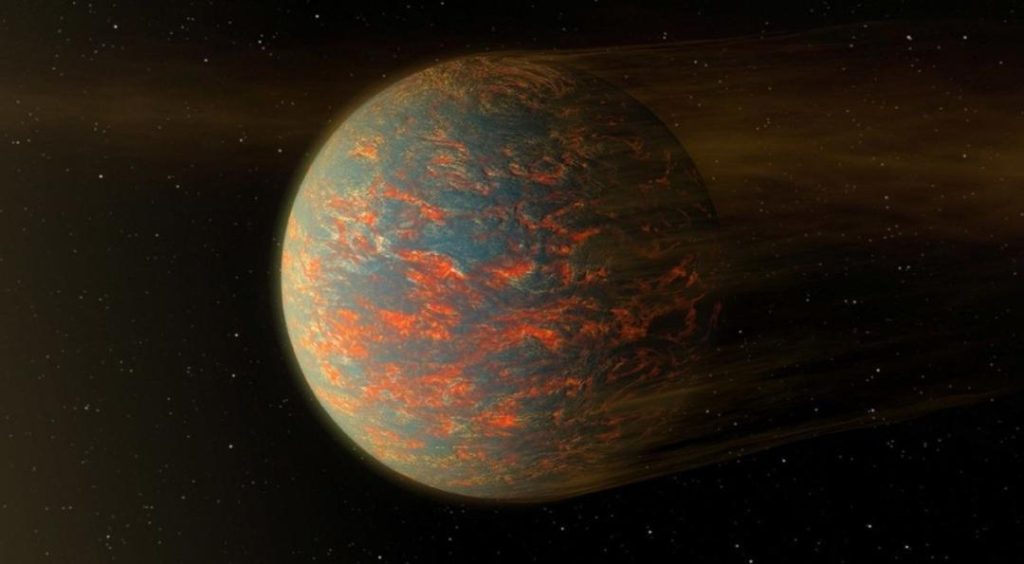
Newly-Discovered Super-Earth Heats Up & Freezes Every 300 Days
The search for life beyond Earth has taken a fascinating turn with the discovery of a newly-discovered “super-Earth” that orbits a Sun-like star just 20 light-years from our planet. This extraordinary planet, dubbed a “super-Earth,” is captivating scientists due to its unique and extreme climate pattern. The newly-discovered exoplanet, which is bigger than Earth but lighter than Neptune and Uranus, swings between scorching heat and freezing cold every 300 days, offering a glimpse into a world that is both fascinating and unsettling.
A World of Contrasts
The newly-discovered super-Earth, which has been named K2-141b, orbits a small, cool star called K2-141, located in the constellation of Cygnus. The star is a G-type main-sequence star, similar to our Sun, but slightly smaller and cooler. K2-141b is about 2.5 times bigger than Earth, making it a super-Earth, but it has a mass that is significantly less than that of Neptune and Uranus.
The most striking feature of K2-141b is its highly elliptical orbit, which takes it from a mere 10% of the star’s distance to a staggering 50% of the star’s distance. This means that the planet experiences extreme temperatures, with the hottest part of its orbit reaching temperatures of over 3,000°F (1,600°C), while the coldest part of its orbit plunges to -400°F (-240°C).
A Tale of Two Climates
As K2-141b orbits its star, it experiences two distinct climates. For the first 150 days, the planet is scorching hot, with surface temperatures reaching those of a furnace. The heat is so intense that it would vaporize any water present on the surface, making it difficult for life as we know it to exist.
But then, things take a drastic turn. As K2-141b moves further away from its star, the temperatures plummet, and the planet becomes a frozen wasteland. The cold is so intense that it would freeze any liquid water present on the surface, making it equally challenging for life to thrive.
This bizarre climate pattern is due to the planet’s highly elliptical orbit, which means that it experiences extreme variations in temperature as it moves closer or further away from its star. This phenomenon is not unique to K2-141b, as other exoplanets have been discovered with similar extreme climate patterns.
Implications for Life
The discovery of K2-141b raises intriguing questions about the potential for life on this extraordinary planet. While the extreme temperatures make it difficult for life as we know it to exist, there are a few possibilities that scientists are exploring.
One possibility is that life could exist in the form of extremophiles, which are organisms that thrive in extreme environments. These microorganisms could potentially survive in the scorching hot temperatures of K2-141b’s surface, or in the frozen wasteland that exists during the planet’s cold phase.
Another possibility is that life could exist in the form of atmospheric gases, such as methane or ammonia, which could be present in the planet’s atmosphere. These gases could potentially support life in the form of microorganisms that thrive in the planet’s atmosphere.
A New Frontier in Exoplanetary Research
The discovery of K2-141b is a significant milestone in the search for life beyond Earth. The planet’s unique climate pattern offers a fascinating opportunity for scientists to study the potential for life on an exoplanet that is both extreme and fascinating.
As scientists continue to study K2-141b, they will gain a deeper understanding of the conditions necessary for life to exist on exoplanets. This research has the potential to shed light on the possibility of life on other planets, and could potentially lead to the discovery of life beyond our solar system.
Sources
- NASA Science News: “Discovery Alert: Super-Earth Swings from Super-Heated to Super-Chill” – https://science.nasa.gov/universe/exoplanets/discovery-alert-super-earth-swings-from-super-heated-to-super-chill/
Note: The link provided is the original news source from NASA Science News, which announced the discovery of K2-141b.






